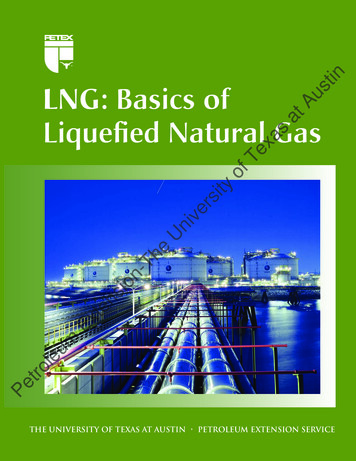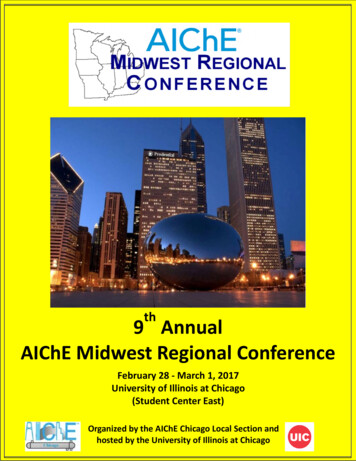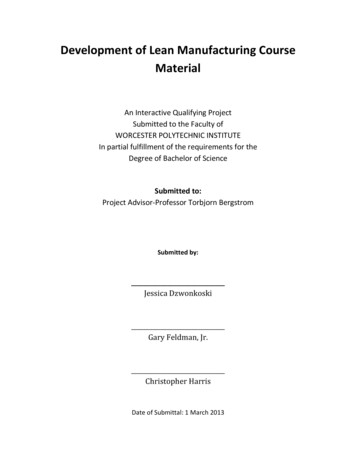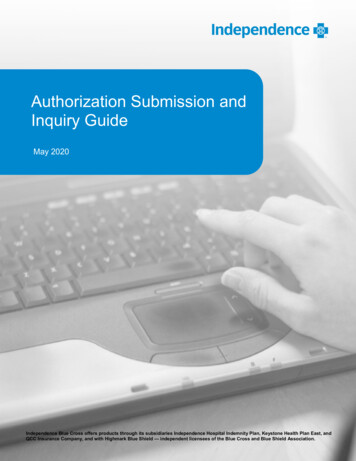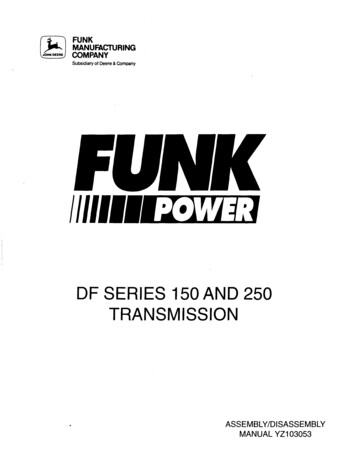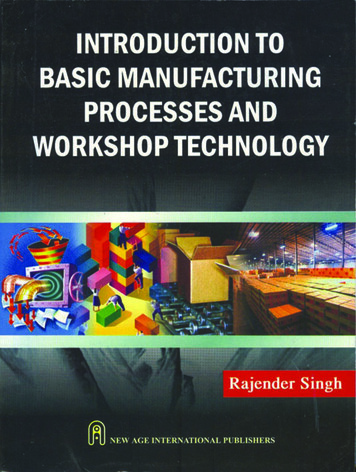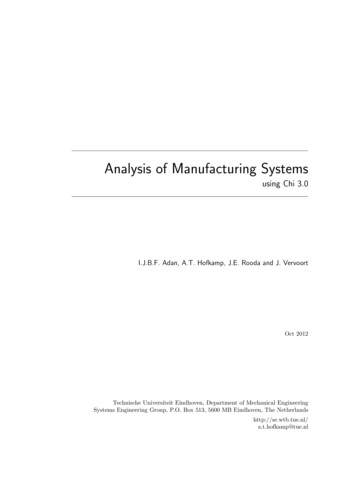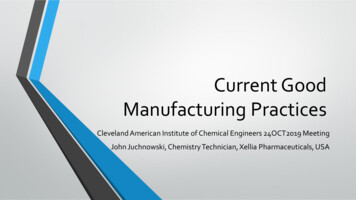
Transcription
Current GoodManufacturing PracticesCleveland American Institute of Chemical Engineers 24OCT2019 MeetingJohn Juchnowski, Chemistry Technician, Xellia Pharmaceuticals, USA
Session in Summary United States Food and Drug AdministrationWhat are CGMPs?FDA ObservationsNeed for Public ProtectioncGMPs in Finished Pharmaceutical ManufacturingRisk ManagementImplications for Performance and CompliancecGMP Seminar Series in Summary with Cleveland StateUniversity
United States Food and Drug Administration Food and Drug Administration– FDA is an agency within the U.S. Department of Health and Human Services– FDA is responsible for protecting public health Ensuring foods are safe and properly labeledEnsuring that human and veterinary drugs, vaccines, and other biological products and medicaldevices intended for human use are safe and effectiveEnsures that cosmetics and dietary supplements are safe and properly labeledAdvancing public health by helping to speed up innovations that make medicines effective, safe,and affordableHelping the public get accurate, science-based information on medicines and foods to maintain andimprove their healthRegulating the manufacturing, marketing, and distribution of tobacco productsEnsuring the security of the food supply, and development of medical products for protection frompublic health threats
What are cGMPs? CGMP refers to the Current Good Manufacturing Practice regulationsenforced by the FDA. Provide for systems that assure proper design, monitoring, and control ofmanufacturing processes and facilities. Adherence to the CGMP regulations assures the identity, strength, quality,and purity of drug products by requiring that manufacturers of medicationsadequately control manufacturing operations. Including:– Strong quality management systems– Obtaining appropriate quality raw materials– Establishing robust operating procedures– Detecting and investigating product quality deviations– Maintaining reliable testing laboratories
What are cGMPs? The CGMP requirements were established to be flexible in order to alloweach manufacturer to decide individually how to best implement thenecessary controls by using scientifically sound design, processing methods,and testing procedures. It is important to note that CGMPs are minimum requirements. Manypharmaceutical manufacturers are already implementing comprehensive,modern quality systems and risk management approaches that exceed theseminimum standards.
What are cGMPs? cGMPs are not just “best practice” they are law. Regulatory requirements of current Good Manufacturing Practices– After an FDA audit inspection of a facility, the FDA may issue a “Form 483” of observations thatrequire a response– If the manufacturer does not respond or remediate the Form 483 observation the FDA may issue awarning letter– If the manufacturer does not respond or remediate the observations in the FDA warning letter, thenthe FDA may have a judge issue a court injunction that will impose a consent decree that stopsmanufacturing If a company is not complying with CGMP regulations, any drug it makesis considered “adulterated” under the law. While FDA cannot force a company to recall a drug, companies usually willrecall voluntarily or at FDA’s request. If a company refuses to recall a drug,FDA can warn the public and can seize the drug.
What are cGMPs? Objectives need to comply with regulations while retaining a highly competitiveposition– Design, delivery, and maintenance of manufacturing support facilities, utilities, process equipment, andautomation control so that they perform as intended to meet business objectives, such as capacity,yield, operational efficiency, and reliability– Development of a production process that can repeatedly produce a quality product– Creation of a quality system necessary to meet regulatory as well as business requirements Criteria: SISPQ: Strength, Identity, Safety, Purity, QualityProject and process deliveries are targeted to be within budgets and schedules and meet or exceedquality attributes.
Top 20 FDA Observations from 2018SeriesCode123456721 CFR 211.22(d)21 CFR 211.160(b)21 CFR 211.19221 CFR 211.100(a)21 CFR 211.67(a)21 CFR 211.68(b)21 CFR 211.67(b)821 CFR 211.110(a)9101112131421 CFR 211.68(a)21 CFR 211.165(a)21 CFR 211.6321 CFR 211.113(b)21 CFR 211.25(a)21 CFR 211.166(a)1521 CFR 211.25(a)161718192021 CFR 211.19221 CFR 211.42(c)(10)(iv)21 CFR 211.22(a)21 CFR 211.100(b)21 CFR 211.165(e)ObservationProcedures not in writing, fully followedScientifically sound laboratory controlsInvestigations of discrepancies, failuresAbsence of Written ProceduresCleaning / Sanitizing / MaintenanceComputer control of master formula recordsWritten procedures not established/followedControl procedures to monitor and validateperformanceCalibration/Inspection/Checking not doneTesting and release for distributionEquipment Design, Size and LocationProcedures for sterile drug productsTraining , Education , Experience overallLack of written stability programTraining--operations, GMPs, writtenproceduresWritten record of investigation incompleteEnvironmental Monitoring SystemLack of quality control unitSOPs not followed / documentedTest 035353433250200150100500123456789 10 11 12 13 14 15 16 17 18 19 20
Need for Public ProtectionWall Street Journal, January 04, 2017 ArticleTwo pharmacists face second degree murder chargesfrom contaminated injectable steroid pain medicationcausing an outbreak of fungal meningitis in 2012.This caused 750 cases of the disease in consumersin 20 states, and resulted in the deaths of 64 people.The New England Compounding Center in Farmington,MA made three contaminated lots for distribution. Thesecompounding pharmacies made drugs, but were notsubject to the same federal quality standards aspharmaceutical companies.This caused congress to pass legislation in 2013 to givethe FDA more authority to regulate product quality atsome compounding facilities but not all.
cGMPs in Finished Pharmaceutical Manufacturing 21 CFR Parts 210 & 211 are applicable to pharmaceutical manufacturing 21 CFR Part 210: CURRENT GOOD MANUFACTURING PRACTICE INMANUFACTURING, PROCESSING, PACKING, OR HOLDING OF DRUGS;GENERAL– 210.1 Status of current good manufacturing practice regulations.(a) The regulations set forth in this part and in parts 211 (Current Good Manufacturing Practice ForFinished Pharmaceuticals), 225 (Current Good Manufacturing Practice For Medicated Feeds), and226 (Current Good Manufacturing Practice For Type A Medicated Articles) of this chapter containthe minimum current good manufacturing practice for methods to be used in, and the facilities orcontrols to be used for, the manufacture, processing, packing, or holding of a drug to assure thatsuch drug meets the requirements of the act as to safety, and has the identity and strength andmeets the quality and purity characteristics that it purports or is represented to possess.– 210.2– 210.3Applicability of current good manufacturing practice regulations.Definitions.
cGMPs in Pharmaceutical Manufacturing 21 CFR Parts 210 & 211 are applicable to pharmaceutical manufacturing 21 CFR Part 211: CURRENT GOOD MANUFACTURING PRACTICE FORFINISHED PHARMACEUTICALS– Subpart A – General Provisions: For prescription drugs, biologics, and OTC drugs– Subpart B – Organization and Personnel: Quality control unit, personnel responsibilities– Subpart C – Buildings and Facilities: Design & construction, lighting, HVAC, plumbing– Subpart D – Equipment: Design & construction, cleaning, maintenance, automation– Subpart E – Control of Components and Drug Product Containers and Closures –Receipt and storage of––––––components, component testing, use and rejectionSubpart F – Production and Process Controls: Written procedures, deviations, Eq. ID’sSubpart G – Packaging and Labeling Control: Examination, labeling, inspection, datingSubpart H – Holding and Distribution: Warehouse and distribution proceduresSubpart I – Laboratory Controls: Test and release for distribution, stability, contaminationSubpart J – Records and Reports: Equipment cleaning log, production records, complaintsSubpart K – Returned and Salvaged Drug Products: Returned drug products, salvaging
cGMPs in Pharmaceutical Manufacturing 21 CFR Parts 210 & 211 are applicable to pharmaceutical manufacturing 21 CFR Part 211: CURRENT GOOD MANUFACTURING PRACTICE FORFINISHED PHARMACEUTICALS– Subpart C – Buildings and Facilities: Design & construction, lighting, HVAC, plumbing– Subpart D – Equipment: Design & construction, cleaning, maintenance, automation
21 CFR Part 211 Subpart C: Buildings and Facilities §211.42Design and construction features.– (a) Any building or buildings used in the manufacture, processing, packing, or holding of adrug product shall be of suitable size, construction and location to facilitate cleaning,maintenance, and proper operations.
21 CFR Part 211 Subpart C: Buildings and Facilities §211.44 Lighting.–Adequate lighting shall be provided in all areas.§211.42 Design and construction features.––––––i) Floors, walls, and ceilings of smooth, hard surfaces that are easily cleanable;(ii) Temperature and humidity controls;(iii) An air supply filtered through high-efficiency particulate air filters under positive pressure, regardless of whether flow islaminar or nonlaminar;(iv) A system for monitoring environmental conditions;(v) A system for cleaning and disinfecting the room and equipment to produce aseptic conditions;(vi) A system for maintaining any equipment used to control the aseptic conditions.
21 CFR Part 211 Subpart C: Buildings and Facilities §211.46Ventilation, air filtration, air heating and cooling.– (b) Equipment for adequate control over air pressure, micro-organisms, dust, humidity, and temperatureshall be provided when appropriate for the manufacture, processing, packing, or holding of a drugproduct.– (iii) An air supply filtered through high-efficiency particulate air filters under positive pressure, regardlessof whether flow is laminar or nonlaminar; §211.58Maintenance.– Any building used in the manufacture, processing, packing, or holding of a drug product shall bemaintained in a good state of repair.
21 CFR Part 211 Subpart C: Buildings and Facilities §211.42Design and construction features.– (c) Operations shall be performed within specifically defined areas of adequate size. There shallbe separate or defined areas or such other control systems for the firm's operations as arenecessary to prevent contamination or mixups during the course of the following procedures: (1) Receipt, identification, storage, and withholding from use of components, drug product containers, closures,and labeling, pending the appropriate sampling, testing, or examination by the quality control unit before releasefor manufacturing or packaging;(2) Holding rejected components, drug product containers, closures, and labeling before disposition;(3) Storage of released components, drug product containers, closures, and labeling;(4) Storage of in-process materials;(5) Manufacturing and processing operations;(6) Packaging and labeling operations;(7) Quarantine storage before release of drug products;(8) Storage of drug products after release;(9) Control and laboratory operations;(10) Aseptic processing
21 CFR Part 211 Subpart C: Buildings and Facilities §211.42 Design and construction features.––(c) Operations shall be performed within specifically defined areas of adequate size. There shall be separate or definedareas or such other control systems for the firm's operations as are necessary to prevent contamination or mixups.(iii) An air supply filtered through high-efficiency particulate air filters under positive pressure, regardless of whether flow islaminar or nonlaminar;Eudralex, Vol4, Annex 1
21 CFR Part 211 Subpart D: Equipment §211.63Equipment design, size, and location.– Equipment used in the manufacture, processing, packing, or holding of a drug productshall be of appropriate design, adequate size, and suitably located to facilitate operationsfor its intended use and for its cleaning and maintenance.
21 CFR Part 211 Subpart D: Equipment §211.65Equipment construction.– (a) Equipment shall be constructed so that surfaces that contact components, in-process materials, ordrug products shall not be reactive, additive, or absorptive.– (b) Any substances required for operation, such as lubricants or coolants, shall not come into contactwith components, drug product containers, closures, in-process materials, or drug products. §211.67Equipment cleaning and maintenance.– (a) Equipment and utensils shall be cleaned, maintained, and, as appropriate for the nature of the drug,sanitized and/or sterilized at appropriate intervals to prevent malfunctions or contamination that wouldalter the drug product beyond the official or other established requirements.
21 CFR Part 211 Subpart D: Equipment §211.65Equipment construction.– (a) Equipment shall be constructed so that surfaces that contact components, in-process materials, ordrug products shall not be reactive, additive, or absorptive.– (b) Any substances required for operation, such as lubricants or coolants, shall not come into contactwith components, drug product containers, closures, in-process materials, or drug products. §211.67Equipment cleaning and maintenance.– (a) Equipment and utensils shall be cleaned, maintained, and, as appropriate for the nature of the drug,sanitized and/or sterilized at appropriate intervals to prevent malfunctions or contamination that wouldalter the drug product beyond the official or other established requirements.
21 CFR Part 211 Subpart D: Equipment §211.72 Filters. Filters for liquid filtration used in the manufacture, processing, or packing of injectable drugproducts intended for human use shall not release fibers into such products. Fiber-releasing filters may be used when it is not possible to manufacture such productswithout the use of these filters. If use of a fiber-releasing filter is necessary, an additionalnonfiber-releasing filter having a maximum nominal pore size rating of 0.2 micron (0.45micron if the manufacturing conditions so dictate) shall subsequently be used to reduce thecontent of particles in the injectable drug product. The use of an asbestos-containing filter is prohibited.
Risk Management The requirements can be satisfied using various methods so designers must bethoroughly knowledgeable of industry practices and systems related to pharmaceuticaldesign Risk Management– Risks that equipment and systems present to product and process helps to ensure thedevelopment of adequate design, mitigation, and control plans that ultimately increaseproduct quality– Product development, process development, and technology focus the informationneeded by the engineering design team– All project risks need to be continuously assessed and controlled, including business risk,contractor performance risk, safety risk, environmental risk, and risk to the patient.– Design and manufacturing practice regulations are the basis for controlling these risks– A pharmaceutical engineer focuses on analyzing, controlling, and managing the risks tothe patient that may be present in the design of the manufacturing process, equipment,utilities, facilities, and automation
Compliance References International Society for Pharmaceutical Engineers– Baseline Guides (created in partnership with FDA) Volume 1: Active Pharmaceutical IngredientsVolume 2: Oral Solid Dosage FormsVolume 3: Sterile Products Manufacturing FacilitiesVolume 4: Water & Steam SystemsVolume 5: Commissioning and QualificationVolume 6: Biopharmaceutical Manufacturing FacilitiesVolume 7: Risk Based Manufacturing of Pharmaceutical Products– Good Practice Guides (best industry practices and solutions) Good Engineering PracticeProject Management in Pharmaceutical IndustryManagement of Engineering StandardsOperations ManagementMaintenanceHeating, Ventilating, and Air Conditioning (HVAC)Process GassesCommissioning & Qualification of Pharmaceutical Water and Steam Systems
Compliance References American Society of Mechanical Engineers (ASME)– BioProcessing Equipment Standards (BPE) General Requirements: Inspection and Manufacturers Quality Assurance ProgramDesign for Sterility and Cleanability: Piping, Tubing, Vessels, and EquipmentDimensions and Tolerances for Stainless Steel Automatic Welding: Swagelok EquipmentMaterials Joining: Orbital Welding, Piping, Tubing, Vessels, PassivationSurface Finish of Stainless Steels: Inspection, Electropolishing, Passivation, RougeEquipment seals, gaskets, and diaphragms: Extractables and Leachables after cleaningPolymer-Based Materials: Polymeric piping, tubing, fittings, valve bodies, and componentsCertification: ASME BPE Certification Stamp on EquipmentMetallic Materials of Construction: Alloy designation, fabrication, and corrosion resistance
Compliance References US FDA– Guidance Documents Data Integrity and Compliance With Drug CGMP Questions and Answers Guidance for IndustryGuidance for Industry Sterile Drug Products Produced by Aseptic Processing — Current GoodManufacturing PracticeCurrent Good Manufacturing Practice for Medical Gases– Inspection Guides High Purity Water Systems (7/93)Lyophilization of Parenterals (7/93)Microbiological Pharmaceutical Quality Control Labs (7/93)Pharmaceutical Quality Control Labs (7/93)Validation of Cleaning Processes (7/93)Dosage Form Drug Manufacturers cGMPs (10/93)Oral Solid Dosage Forms Pre/Post Approval Issues (1/94)Sterile Drug Substance Manufacturers (7/94)Topical Drug Products (7/94)Oral Solutions and Suspensions (8/94)
FDA Design & Construction Features Process Qualification– Determine if it is capable of reproducible commercial manufacture Design of the facility and qualification of the equipment and utilitiesProcess performance qualification–––cGMP compliant procedures must be followedSuccessful completion of process qualification is necessary before commercial distributionProducts manufactured during this stage, is acceptable, can be released for distribution
FDA Design & Construction Features Design of a Facility and Qualification of Utilities and Equipment– Proper design of a manufacturing facility is required under part 211, Subpart C, of the cGMPregulations on buildings and facilities– Activities performed to ensure proper facility design and commissioning precede processperformance qualification Selecting appropriate utilities and equipment construction materials, operating principles, and performancecharacteristicsVerifying that utility systems and equipment are built and installed in compliance with the design specificationsVerifying that utility systems and equipment operate in accordance with the process requirements in allanticipated operating ranges. Also challenging the equipment or system functions at startup, shutdown, maximumor minimum runs– Qualification of utilities and equipment can be under individual plans or as part of an overall projectplan Plan identifies: Tests to use, assessment criteria, timing of activities, responsibilities, approval procedures
FDA Design & Construction Features The quality control unit must review and approve the qualification plan and report– The project plan should include the firm’s requirements for the evaluation of changes– Qualification activities should be documented and summarized on a report with conclusions thataddress criteria in the plan– The quality control unit must review and approve the qualification plan and report (21CFR211.22)– The quality system model four factors: Management responsibilities, Resources, ManufacturingOperations, and Evaluation activities Under a quality system the technical experts (engineers & development scientists)are responsible for defining specific facility and equipment requirements– Under cGMP regulations the quality unit must review and approve all initial design criteria andprocedures for facilities and equipment (21CFR211.22c)– Under cGMP regulations equipment must be qualified, calibrated, cleaned, and maintained toprevent contamination and mix-up (21CFR211.63, 211.67, 211.68)– The full text of 21CFR210 and 211with Quality Systems Approach to Pharmaceutical cGMPRegulations guidance can be obtained from http://www.FDA.gov
Implications for Performance and Compliance Implications for Performance and Compliance– The scope and overall approach for the development of the regulatory and quality strategy throughoutthe project life cycle is dictated by the project scope and objectives. Integrating this strategy into theproject management effort provides key input for the design approach and for overall project success. Requirements and Design; Phase 1– Engineering team develops the design from concept through construction– Project team defines cGMP aspects of project life cycle and documents them in validation plan– The validation plan is developed in parallel with the basis of design for the facility– Goals and objectives of the manufacturing unit depend on corporate philosophy, operating principles,and regulatory requirements– Capital investments must meet criteria for Return on Investment (ROI) before funds are committed– cGMP regulations provide requirements for the design of the facility– User Requirement Specifications (URS) define expectations of end user of equipment and systems– Process flow diagrams are used to show basic steps of manufacturing process to help with analysis– Engineering and Validation teams have approved Validation Master Plan before construction
Implications for Performance and Compliance Construction of Equipment, Systems, and Facilities and Testing; Phase 2– Equipment fabricators, service providers, and trade contractors receive the URS and generate a FunctionalRequirement Specification (FRS) that details how they will provide what the URS calls for and a DesignSpecification (DS) detailing how the equipment or system will be built to comply with the cGMPs– After FDS has owner approval the suppliers will generate P&IDs, mechanical, piping, electrical, structural,automation, and architectural drawings for construction– After construction the following testing will occur, and those items that affect product quality and patientsafety will receive the most attention by Subject Matter Experts (SMEs) Factory Acceptance Test (FAT) the equipment at the fabricator’s factory before shipmentSite Acceptance Test (SAT) the equipment at the pharmaceutical site after shipmentInstallation Qualification (IQ) will test the equipment for the detailed Design Specifications (DS)Operational Qualification (OQ) will test the equipment for the Functional Requirement Specifications (FRS)Performance Qualification (PQ) will test the equipment for the User Requirement Specifications (URS)– Project Change Management system to track changes during project for budget and schedule control
Implications for Performance and Compliance Turnover Phase 3– Formal execution of all testing work– Process equipment and systems test protocols are approved for intended manufacturing operations– Process equipment and systems test protocols will be reviewed by a Subject Matter Expert,engineering, maintenance, manufacturing, validation and quality if the equipment/system is critical– Project size will have impact on staging commissioning, qualification, and validation (CQV) of noncritical systems needed for critical systems (air & water & steam for WFI)– Project complexity will have impact on long lead times for specialty equipment needing construction,transportation, and programming– Existing facility upgrades, retrofit projects, and expansion projects have challenges to keep theexisting process in operation and profitable while constructing a new process around it– Unknown product and process requirements are not scaled up to production from pilot plant scale todefine the utility loads and reactor geometry for mixing/heat transfer/mass transfer parameters
Implications for Performance and ComplianceProject LIFE Compounding Vessel Skid Installation Qualifications and Operational Qualification Protocol Tests
Global Regulatory Environment Global Regulatory Environment– Global regulations in a harmonized approach for a better understanding by various national authorities toalign approaches to regulatory compliance: The International Conference on Harmonization (ICH); www.ich.orgThe International Organization for Standardization (ISO); Part of ICHThe American Society for Testing and Materials (ASTM) International; www.astm.orgThe World Health Organization (WHO); www.who.int/enFood and Drug Administration (FDA); www.fda.govEuropean Medicines Agency (EMA); www.ema.europa.eu/ema– Regulator Expectations Design, operating, and quality decisions are based on scientific knowledge of product and process.Attributes of the product necessary to deliver the desired effect to the patient are known Risks to the patient should be understood and managed. This understanding will drive the design,operation, and quality system of the manufacturing operationA comprehensive quality system for designing, verifying, and maintaining process, equipment, andsystems is in place.
cGMP Seminar Series in 8.19.Pharmaceutical Industry ProfileCurrent Good Manufacturing PracticesProcess EngineeringContainment Technology (Isolators & RABS)High Purity Water SystemsQA / QC Laboratories and Related Support SpacesFacility Utility SystemsLegacy Facility Master PlanningArchitectural Design & Midterm ExamSterile Manufacturing FacilitiesBiotechnology FacilitiesCodes and StandardsCommissioning, Qualification, and ValidationOccupational Health and SafetySustainability (LEEDs)Process AutomationPackaging and WarehousingFinal ExamAwards Ceremony
Session in Summary United States Food and Drug AdministrationWhat are CGMPs?FDA ObservationsNeed for Public ProtectioncGMPs in Finished Pharmaceutical ManufacturingRisk ManagementImplications for Performance and CompliancecGMP Seminar Series in Summary with ClevelandState University
Questions?
10 21 CFR 211.165(a) Testing and release for distribution 56 11 21 CFR 211.63 Equipment Design, Size and Location 53 12 21 CFR 211.113(b) Procedures for sterile drug products 50 13 21 CFR 211.25(a) Training , Education , Experience overall 47 14 21 CFR 211.166(a) Lack of written stability program 47 15 21 CFR 211.25(a) Training--operations .

